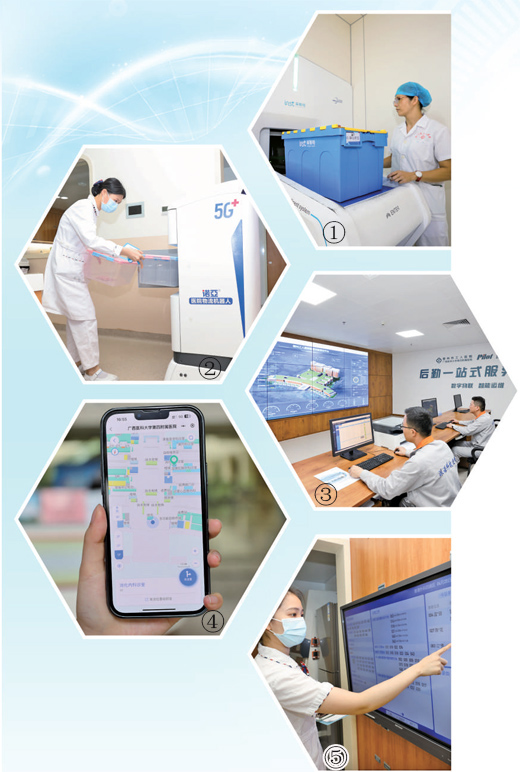Smart hospital in China's Guangxi boosts patient care
In recent years, the Workers' Hospital of Liuzhou, located in the city of Liuzhou, south China’s Guangxi Zhuang Autonomous Region, has made significant advancements in the construction of smart facilities. By adopting digital technologies in various areas, such as outpatient and inpatient treatments, as well as logistics, the hospital aligns its standards with those of smart healthcare, smart services, and smart management. As a result, it offers more convenient medical services to patients.
Li Fangfang, a patient visiting the hospital for the first time – also known as the Fourth Affiliated Hospital of Guangxi Medical University – managed to locate the cardiology department quickly. This was made possible by a voice prompt from a mini-program on her phone that enabled navigation within the hospital.

① A medical worker uses an intelligent transport system at the Workers' Hospital of Liuzhou in Liuzhou city, south China's Guangxi Zhuang Autonomous Region.
② A nurse takes medicine delivered by a robot at the Workers' Hospital of Liuzhou in Liuzhou city, south China's Guangxi Zhuang Autonomous Region.
③ Staff members use a platform for smart logistics management at the Workers' Hospital of Liuzhou in Liuzhou city, south China's Guangxi Zhuang Autonomous Region.
④ A person uses the navigation system of the Workers' Hospital of Liuzhou on a mobile phone.
⑤ A nurse checks patients' information on a screen at the Workers' Hospital of Liuzhou in Liuzhou city, south China's Guangxi Zhuang Autonomous Region. (Photos/Chen Xinyuan)
Liang Xuxin, director of the hospital's information division, explained that sensors installed throughout the hospital's clinic department, emergency department, and inpatient building provide precise positioning and real-time navigation within the hospital once connected to a phone via Bluetooth.
In the cardiology department, cardiologist Xia Meng was able to check the medical images Li had received from other hospitals in the city online.
"Our hospital was connected to Liuzhou city's online platform for medical images on April 1 this year. Therefore, we can check online patients' medical results, medical records, and medical images in other hospitals," Xia said, adding that it is more convenient for patients.
After examining and diagnosing Li, Xia prescribed her medication. He then directed her to the hospital's pharmacy, which is equipped with two automated drug dispensing machines, to collect her medicine. This could be done after paying the fees through the hospital's mini-program.
The hospital provides medical consultation services to patients via its mini-program. "It's free, and I can consult doctors online anytime. It's so great," Li praised.
Huang Haixin, the head of the hospital, said the hospital was recognized as an internet-based institution in October 2020, which has enabled patients to access medical services with greater ease.
The Workers' Hospital of Liuzhou employs automated devices for blood collection. This includes a conveyor belt that transports tubes with blood samples to the hospital's laboratory and an automated mass spectrometry microbial identification system, explained Wu Hao, the director of the hospital's laboratory medicine department. The automated devices have reduced the time required for blood collection by an average of 40 to 50 percent.
Automated devices, including surgical robots, are extensively used in the hospital's operating rooms. Surgical robots provide a clearer vision and significantly reduce operation time, according to Zhang Yanzhuo, the director of the anesthesiology department at the hospital. Additionally, family members of patients can monitor the progress of the operation through a mini-program, while corresponding departments in the inpatient building can immediately understand the status of the surgery thanks to internet connectivity.
The hospital also employs an intelligent, medium-sized transport system in each department. This system transfers drugs, specimens, consumables, and other materials, boasting an average delivery time of just six minutes per box. To date, the system has transported over 450,000 boxes of materials, averaging 485 boxes per day, thereby significantly enhancing efficiency.
Additionally, the hospital utilizes an Internet of Things (IoT) platform for smart logistics management.
The IoT logistics platform can automatically monitor various aspects of the hospital's infrastructure, including distribution rooms, the central air-conditioning system, the logistics system, sewage treatment, and medical gases, among others. The platform can send early warnings, ensuring more accurate and timely fault detection and more standardized daily inspection.
Thanks to the IoT logistics platform, the hospital has significantly reduced equipment energy consumption and improved efficiency. For instance, the daily electricity consumption of the central air-conditioning system has been reduced from over 80,000 kilowatt-hours to 70,000 kilowatt-hours.
Under the guidance of Guangxi's health commission, medical institutions in the autonomous region have expedited their implementation of smart medical services. As of December 2022, Guangxi had established 35 internet-based hospitals.
"In the future, we hope to make better use of artificial intelligence, cloud computing, and other technologies to build a big data center to provide patients with higher-quality, efficient and convenient medical services," Huang said.
Photos
Related Stories
- Hospitals call for maternity-friendly society
- Hospitals strive to preserve fertility for cancer patients
- With virus threat easing, U.S. hospitals still as full as ever: media
- China improves service capacity of rural, community-level hospitals as Spring Festival draws near
- Hospitals prepared for surge in cases
Copyright © 2023 People's Daily Online. All Rights Reserved.









